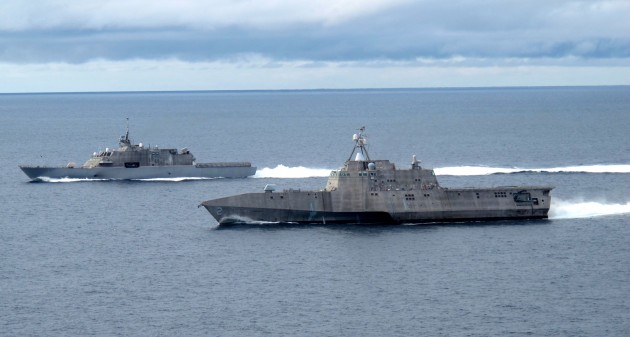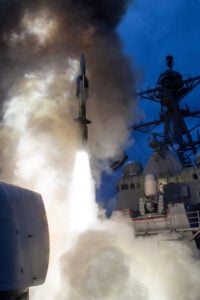LCS Lives: Hagel Approves Better Armed Upgrade
Posted on

The two Littoral Combat Ship variants, LCS-1 Freedom (far) and LCS-2 Independence (near).
PENTAGON: The controversial Littoral Combat Ship dodged a big torpedo today, when outgoing Defense Secretary Chuck Hagel approved the Navy’s plan for a larger, better armed and better protected version of the ship. Critics had called for a radical redesign or an entirely new ship. The “modified LCS” simply adds new weapons, electronics, and armor to the two existing LCS variants for an additional $60-$75 million per ship.
“After rigorous review and analysis, today I accepted the Navy’s recommendation to build a new small surface combatant (SSC) ship based on upgraded variants of the LCS,” Defense Secretary Chuck Hagel said in a statement early this evening. “The new SSC will offer improvements in ship lethality and survivability, delivering enhanced naval combat performance at an affordable price.”
Arguably the biggest change: the new version will not be able to serve as a minesweeper, focusing instead on fighting enemy surface vessels and submarines.

The upgraded version of the LCS-1 Freedom class
The Navy remains committed to buying both the speedboat-like Freedom hull, built by Lockheed Martin and Marinette Marine in Wisconsin, and the space-age-catamaran Independence, built by General Dynamics and Austal in Alabama. Between them, the two teams will build 52 Littoral Combat Ships, as was the plan before Sec. Hagel ordered a review of LCS in February. Today’s announcement simply means 32 of those will be the original LCS design and 20 will be the upgraded version. (At least some of the original 32 will eventually receive at least some of the upgrades, but the current design can’t accommodate all the changes).
The split between the teams and terms of competition remains to be determined: The Navy will submit an acquisition strategy to the secretary by May and work out detailed cost estimates as part of the budget process for 2017. While the shipbuilders themselves will remain the same, there may be multiple opportunities to compete on specific components of the upgrade package, such as new missiles and sensors.

The upgraded version of the LCS-2 Independence.
So what’s the difference between the “modified LCS” and the current design (bizarrely designated “Flight Zero Plus”)? The new version gets a lot more combat power for not much more cost, insisted the Chief of Naval Operations, Adm. Jonathan Greenert, and the Navy’s top procurement official, Assistant Secretary Sean Stackley, at a hastily convened roundtable with reporters this evening.
“Are you going to need an Aegis ship to protect this ship? The answer is no,” said Stackley. One major criticism of the original LCS was that it lacked the anti-aircraft and anti-missile defenses to survive on its own against any serious threat, requiring escort by expensive cruisers and destroyers equipped with the Aegis defense system. While threat environments vary, Stackley said, “we have given this multi-mission [LCS] the degree of self-defense that it needs so it does not have to be operating underneath the umbrella of an Aegis ship.”
Unlike an Aegis ship, however, the new LCS design does not have the Navy’s standard multi-purpose missile-launcher, the Vertical Launch System. Used on larger craft from cruisers to attack submarines, VLS can fire different kinds of rounds to shoot down incoming aircraft and missiles, strike land targets, or — once the Navy finishes developing a new long-range anti-ship missile — sink enemy warships. Outsiders, including one of Greenert’s former aides, argued an LCS with VLS would be much more able to attack a wide range of targets and defend itself or even other ships against a wide range of threats.

Adm. Jonathan Greenert briefs reporters on the new LCS
“They did evaluate a Vertical Launch System,” Adm. Greenert said. But it was “kind of heavy, kind of big, a major change [adding] cost, time. It was all part of the evaluation, Sydney, so it was considered.” But ultimately the Small Surface Combatant Task Force charged to review alternatives to the current LCS found adding a Vertical Launch System cost too much in terms of money, production delays, and weight for what it added, Greenert said.
What the new LCS will have, and the current one does not, is an over-the-horizon anti-ship missile: The Navy will probably hold a competition for the exact system, but Stackley said it would be at least comparable to the Harpoon Block II, which has about a 70-mile range.
For self defense, the new LCS will have an upgraded version of the current model’s SeaRAM missile launcher. It will also add new 25 millimeter heavy machineguns. (The Navy decided against adding a 5-inch cannon, though, to traditionalists’ dismay). It have new decoy launchers and anti-torpedo defenses. An advanced degaussing system will make the hull’s magnetic field less detectable by naval mines.
To detect threats, the new LCS will have an upgraded radar and a “multifunction towed array” to detect torpedoes and submarines. When configured for all-out sub hunts, it will replace some of its anti-ship weapons with a variable-depth sonar — making it, said Stackley, “the most effective ASW [anti-submarine warfare] platform in the Navy.”

A Vertical Launch System (VLS) firing.
From Adm. Greenert’s perspective, though, the most exciting new addition “would be the upgraded EW [electronic warfare] system,” he said. While the new LCS won’t get the full Surface Electronic Warfare Improvement Program (SEWIP) Block II being developed for larger warships, it will get what Greenert called “SEWIP-light.” That allows for a “soft-kill” of incoming missiles, not by shooting them down but by scrambling their electronics.
Finally, if the enemy does manage to land a blow, the new LCS will be much better able to survive and recover, Stackley said. Crucial compartments on the ship will have additional armor and key systems will be hardened against shock. While the Navy doesn’t use its traditional Level 1/2/3 system of survivability ratings anymore, Stackley said the new LCS’s robustness “matches what we would have for a frigate” — a significantly larger class of vessel that Hagel himself ordered the Navy to consider as a replacement for LCS.
So how can the Navy cram all this new stuff into the existing hull designs? The current LCS is built as a “modular” design that can configured as a minesweeper, sub-hunter, or anti-ship combatant — but not all three at once. The new LCS, by contrast, will need some plug-and-play systems for specific missions, but it will always carry both its over-the-horizon missile launcher — an anti-ship weapon — and its towed array — anti-submarine — in addition to the new defenses.

Sean Stackley, Assistant Secretary of the Navy
That’s possible because the task force scoured the LCS design for places to cut weight. “We’ve looked at every item on the ship,” Stackley said. Every pound nipped and tucked from non-essential systems was more for weapons, sensors, and armor. That process will continue as designs get more detailed. It’s likely the new LCS will end up somewhat heavier than the current design, Stackley said, but that will only slow the ship by a few knots. That’s not a major sacrifice given that the Navy designed the LCS for a blisteringly fast 40-plus knots and then struggled to figure out what, tactically, all that speed was for.
The one real sacrifice in the new LCS design is the ability to clear mines. That mission will be left to the 32 original-model Littoral Combat Ships — which, Greenert insisted, was enough to handle “the most stressing” possible scenarios. What the theater commanders around the world wanted most, Stackley said, was not minesweeping but the ability to combat both surface craft and submarines. That is the mission against which the new LCS will be measured.
Subscribe to our newsletter
Promotions, new products and sales. Directly to your inbox.
